 |
 |
The information expressed herein should be treated as opinion. No guarantee is given or implied that any advice on the web-site is necessarily correct. Nor might it best suit other divers and clubs due to regional and personal differences. Diving is a risk sport - all advice herein should be validated with advice from your own diving club, governing body, or approved published material before being adopted.
The biggest problem of buoyancy is the vicious circle - ascend a bit and the air in your BCD expands a bit.
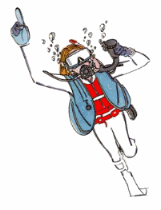 |
Expanded air is
more buoyant, so you ascend faster. As you ascend, air expands even more, so you ascend faster still, and so on; so the later you leave it to correct positive buoyancy, the harder it is to get it back to normal - until you reach a point where it's expanding faster than you can dump and you can't avoid going to the surface. This will often end in a bend. The only avoidance is early correction. Keep buoyancy neutral at all times. Never forget the fastest way of dumping - breathe fully out, this gets rid of at least 2 litres and often nearer 4, and works at any swimming angle. The instant you spot you're going up a bit too much, make it a reflex to exhale fast as your first immediate response & hold it out, at the same time go for the dumps. While dumping, can slowly begin to inhale as buoyancy control is regained. |
Dry suits can be dangerous with a risk of an uncontrolled ascent. There are worse problems if you are inverted as there is no way for air to get out. The best avoidance is to dive with a semi-dry! Seriously, ask if your kind of diving really needs a dry suit. If it honestly does - OK. The next best thing is to keep buoyancy correct every second of dive. Small corrections early are easy. Large ones after problem start are impossible. The next most important thing is not to dive too heavily weighted; this makes you put too much air in the suit or BCD.
| Example:Go up just from 10m to 3m and air expands over 50%. If weighted well with only, say, 10 litres of air in suit/BCD, then that adds only 5 litres more air to get rid of. With 2kg too much weight at the surface you will need 4 litres more air at 10m to be neutral. The same ascent from 10m to 3m will then add 50% of 14 litres, or 7 litres more air - an extra 2 litres to lose. This demonstrates how being over-weighted makes the ascent spiral problem worse. If you get into an ascent spiral, do an emergency air dump by pulling the neck seal open. This will get you wet and cold but at least you will not be bent. If you get inverted you must correct it quickly. It's even more dangerous to be too light of course. Remember you can lose over 3kg weight of air breathed from a single cylinder by the end of the dive. Without a shot line or reef to hold on to you can't avoid missed stops. So, get weighting exactly right in your dry suit. Test fully kitted up in target type of water (sea or fresh - weighting's different) with 50 bar in the cylinder so you can just float at eye-level and sink if you breathe out. | 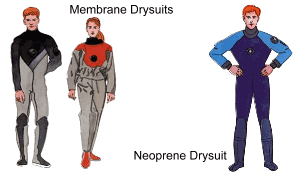 |
There are two schools of thought:
Don't skip a breath - you'll risk a burst lung, a build up of CO2 and at the very least get a headache. CO2 will also trigger panting which only makes air usage even worse. The only safe way to use less air is to breathe normally but use less energy. Relax - Hard work builds up CO2, makes you pant and uses more air (worse still it increases blood flow during the dive and thus a risk of decompression illness). Less effort is not only safer, but makes diving more enjoyable too. To use less energy (biggest savings first):
You're more likely to be lost than drowned. It is incredibly hard to see a diver on the surface as there's just a small black head bobbing about and sometimes impossible in big seas or poor air viz. Increase your visibility. The Coastguard recommends a collapsible flag carried in elastic cords around the cylinder which can be deployed if the boat cannot see you. It's cheap and highly effective but can be cumbersome. The best and most practical is a delayed SMB which is also multi-functional.
A brightly coloured hood is also recommended; if you have a black hood, stitch cyclists reflective plastic strips to it, or buy special Day-Glo over-hood. A more expensive option is EPIRB - Emergency Position Indicating Radio Beacon which sits in a small watertight box. The EPIRB emits an international distress frequency radio signal which can be picked up by helicopters, boats, planes, and (for more powerful ones) satellites. The signal warns of a problem and guides help to you. Works in fog, darkness, high seas. Almost ideal.
The main thing is to all agree how it will work before diving. The safest approach is for each diver to look out for both the others equally. If either goes missing for any reason, pair up with the remaining diver and follow the lost buddy procedure with both surfacing after one minute to check where the third diver is and raise an alarm if has not surfaced.
A more common "buddy pair with one tagging along" approach is not as safe.
Worst situation is not to have agreed how the threesome will operate before the dive. Very common here for one diver to go missing then other two are tempted to continue dive on assumption third went off solo deliberately or "can look after himself". This often turns out OK, but it's only luck that it does. It can be fatal!
|
SMBs let boat cover keep track of you (reduces divers lost at sea) and marks where you will be surfacing (stops you being hit). Use one always - especially on drift dives - unless
If you are not using an SMB for any reason, you must have a Delayed SMB with you instead. |
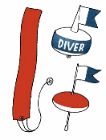 |
At least 2 minutes before the end of your Bottom Time:
Don't deploy a DSMB with an unanchored
standard reel. The reel may jam then either you lose the surface cover/tracking
or get pulled up and miss any decompression/safety stops.
For unavoidable mid-water DSMB, use twin reels so if one jams can release whole
DSMB rig to go up on second reel (and hope that doesn't jam).
It's easy to lose a buddy on a fast drift dive. Poor viz, or buddy your clinging onto something gets a pair parted in a split second.
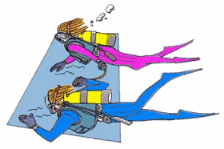 |
Using a buddy line is one
approach; another is to use a SMB line. You should always have an SMB on a drift dive anyway, so feed out more line and let your buddy (or buddies), using gloves, hang on a few metres away. |
You should always take a DSMB on a wreck dive.
| If all divers
have them, the skipper may plan to lift the shotline as soon as all divers
are down - find out! If not, you may want to come back up the shot anyway. In very good viz, small wreck and easy navigation points, free-swimming is no problem. |
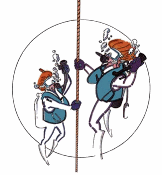 |
In poor viz you may need a pathfinder. Attach the end of the line from a second reel (keep DSMB reel in case you have to cut loose and ascend without pathfinder reel) to some wreckage near the shotline (never to the shot line itself in case the skipper does lift it!). Pay out line as the dive progresses and reel it in to get back to shot. |
Read the manual and play with it a lot. Get to know the meaning of every number and display icon without having to think about it. Use it as teaching aid - watch it and think during dives to learn how diving behaviour affects your decompression obligation and change your diving behaviour in future to lower it.
 |
If you are new to PDCs:
|
 |
Always know when your next medical is due. Keep it up to date and let the club secretary have a copy of the signed medical certificate for club records. If you suspect that you are overweight, calculate your BMI (Body Mass Index) well before the medical. Note your height in metres (e.g. 1.65) and weight in Kg (e.g. 81Kg).
To obtain a medical, get a blank medical form from the club DO or Secretary. Fill in the front page and take it to your doctor. If this is your first medical, ask the club committee for advice on the best and cheapest doctors. Some occasionally do diving medicals very cheap or even free for long standing registered patients. More commonly now, they see it as a great source of extra income and charge exorbitant rates (nearly £60 in some cases). You can get a medical for under £30 from some places so look around.
When going for medical, be aware you'll need to give a urine sample. If the doctor is not happy with everything as it may be a borderline case you can ask to get a diving doctor to referee. Finally, don't forget to give the club a copy of the certificate and notify the D.O. of any restrictions applied by doctor or referee.
Copyright © 2007 Chippenham Diving Club - BSAC1622 |
| Home Page | Site Map | Club Info | UK Diving | Club Contacts | Top Links |